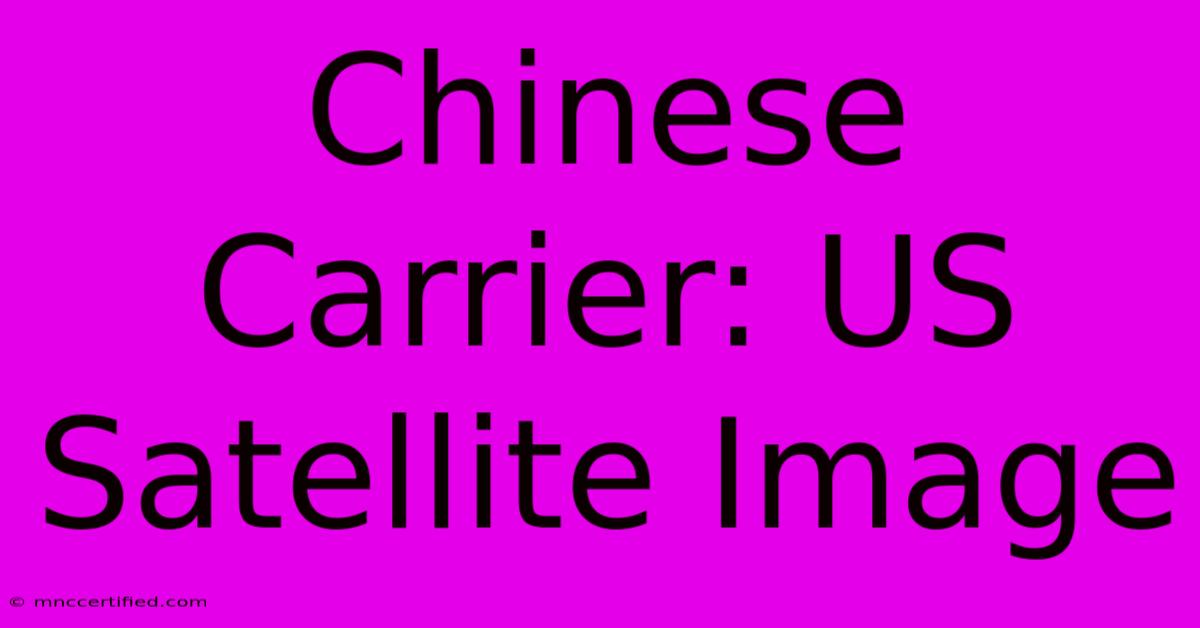Chinese Carrier: US Satellite Image

Table of Contents
Chinese Carrier: US Satellite Image – Deciphering the Geopolitical Implications
The release of US satellite images depicting Chinese aircraft carriers has become a recurring event, sparking considerable geopolitical discussion and analysis. These images, often high-resolution and detailed, offer valuable insights into the People's Liberation Army Navy (PLAN)'s capabilities, deployments, and strategic intentions. Understanding the context surrounding these images, the information they reveal, and their implications is crucial for comprehending the evolving dynamics of the Indo-Pacific region.
What US Satellite Images Reveal About Chinese Carriers
US satellite imagery provides a wealth of information about Chinese aircraft carriers, far exceeding what's publicly available through official Chinese channels. This includes:
-
Carrier Location and Movements: Images pinpoint the exact location and track the movements of carriers, allowing analysts to map their deployment patterns and infer their operational objectives. This is crucial for monitoring potential power projection capabilities in disputed areas like the South China Sea.
-
Aircraft and Equipment: High-resolution images allow identification of specific aircraft types onboard, revealing details about the carrier air wing's composition and capabilities. This includes the numbers of J-15 fighter jets, early warning aircraft, and helicopters, providing insight into the carrier's combat readiness.
-
Operational Status: Images can show the carrier's operational status – whether it's undergoing maintenance, training exercises, or preparing for deployment. This helps assess the PLAN's overall naval readiness and preparedness for potential conflict scenarios.
-
Infrastructure Development: Satellite images can also capture images of supporting infrastructure, such as naval bases and port facilities, providing context for carrier operations and highlighting potential areas of future expansion. This includes assessing the capacity for maintenance, resupply, and crew changes.
Beyond the Visual: Analyzing the Geopolitical Implications
The release of these images, often by US government agencies or media outlets, carries significant geopolitical weight. Several key implications arise:
-
Power Projection: The images underscore China's growing naval power and its expanding ability to project military force across the Indo-Pacific region. This challenges established regional power dynamics and raises concerns among neighboring countries.
-
Military Transparency (or Lack Thereof): The reliance on US satellite imagery to understand China's naval capabilities highlights a lack of transparency in China's military activities. The contrast between the detailed US imagery and the limited information offered by China itself fuels suspicions and mistrust.
-
Strategic Deterrence: The public release of these images can be interpreted as a form of strategic deterrence, sending a message to China about the US's awareness of its naval activities. This serves as a form of indirect pressure and signals a commitment to maintaining regional stability.
-
Arms Race Concerns: The ongoing development and deployment of Chinese aircraft carriers raise concerns about an escalating arms race in the region. This leads to increased military spending by other countries in response, further destabilizing the security landscape.
The Role of Open-Source Intelligence (OSINT)
Satellite imagery forms a crucial component of Open-Source Intelligence (OSINT), a powerful tool for analyzing geopolitical events. By combining satellite imagery with other publicly available data – news reports, social media posts, and shipping data – analysts can build a comprehensive picture of the situation. This is particularly crucial in regions where information flow is restricted or manipulated.
Conclusion: A Continuous Watch
US satellite images of Chinese carriers are not simply snapshots; they are dynamic pieces of evidence in an ongoing geopolitical puzzle. Continuously monitoring these images and analyzing their implications is essential for understanding the evolving power dynamics in the Indo-Pacific and the broader global security landscape. The future will likely see even more sophisticated satellite technology, leading to even more detailed and frequent releases of such imagery, further shaping our understanding of China's naval ambitions and the region's strategic future. This necessitates continuous research and insightful analysis to fully grasp the implications of this ongoing surveillance.

Thank you for visiting our website wich cover about Chinese Carrier: US Satellite Image. We hope the information provided has been useful to you. Feel free to contact us if you have any questions or need further assistance. See you next time and dont miss to bookmark.
Featured Posts
-
Peter Mask Chers Strong Reaction
Nov 23, 2024
-
Gatwick Terminal Reopens Bomb Scare Ends
Nov 23, 2024
-
Does Insurance Report To Carfax
Nov 23, 2024
-
Trump Again Promises Jfk Files Release
Nov 23, 2024
-
Bayerns Winter Friendlies Matches Against Greuther Set
Nov 23, 2024